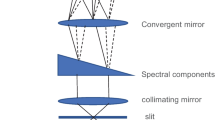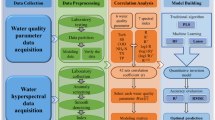Abstract
An empirical approach through remote sensing generally produces a robust data model of water quality for inland and coastal water. Traditional regressions in water quality mapping fail because the bio-optical relationship of turbid water exhibits nonlinear and heterogeneous patterns. In addition, in situ data are generally insufficient in the water quality mapping. Mapping based on a relatively small amount of water quality samples is considered a practical issue in environmental monitoring. Learning-based algorithms that require a large amount of data are inapplicable in this case. According to the concept of Nadaraya–Watson estimator, the kernel model can estimate nonlinear and spatially varying water quality maps effectively in turbid water.
Experiments indicate that the kernel estimator provides better goodness-of-fit between the observed and derived concentrations of water quality parameter, e.g., chlorophyll-a in turbid water. The kernel estimator is feasible for a relatively small size of ground observations. Approximately 30% improvement of cross-validation error was identified in this approach when compared with traditional regressions. The model offers a robust approach without further calibrations for estimating the spatial patterns of water quality by using remote sensing reflectance and a small set of observations, considering spatial and spectral information, e.g., multiple bands and band ratios.






Similar content being viewed by others
References
Aljuhani, K. H. (2014). Modification of the adaptive nadaraya-Watson kernel regression estimator. Scientific Research and Essays, 9, 966–971.
Bailey, S. W., Franz, B. A., & Werdell, P. J. (2010). Estimation of near-infrared water-leaving reflectance for satellite ocean color data processing. Optics Express, 18, 7521–7527.
Belkin, M., Hsu, D., & Mitra, P. P. (2018, December). Overfitting or perfect fitting? risk bounds for classification and regression rules that interpolate. In Proceedings of the 32nd International Conference on Neural Information Processing Systems (pp. 2306–2317). Curran Associates Inc.
Blix, K., & Eltoft, T. (2018). Machine learning automatic model selection algorithm for oceanic chlorophyll-a content retrieval. Remote Sensing, 10, 775.
Bowman, A. W., & Azzalini, A. (1997). Applied smoothing techniques for data analysis: the kernel approach with S-plus illustrations. Oxford: OUP.
Brando, V. E., & Dekker, A. G. (2003). Satellite hyperspectral remote sensing for estimating estuarine and coastal water quality. IEEE Transactions on Geoscience and Remote Sensing, 41, 1378–1387.
Cai, Z. (2001). Weighted Nadaraya–Watson regression estimation. Statistics & Probability Letters, 51, 307–318.
Chang, N.-B., Bai, K., & Chen, C.-F. (2017). Integrating multisensor satellite data merging and image reconstruction in support of machine learning for better water quality management. Journal of Environmental Management, 201, 227–240.
Cheng, C., Wei, Y., Sun, X., & Zhou, Y. (2013). Estimation of chlorophyll-a concentration in turbid lake using spectral smoothing and derivative analysis. International Journal of Environmental Research and Public Health, 10, 2979–2994.
Chu, H.-J., Kong, S.-J., & Chang, C.-H. (2018). Spatio-temporal water quality mapping from satellite images using geographically and temporally weighted regression. International Journal of Applied Earth Observation and Geoinformation, 65, 1–11.
Chu, H.-J., VAN Nguyen, M., & Jaelani, L. M. (2020). Satellite-based water quality mapping from sequential simulation with parameter outlier removal. Water Resources Management, 34, 311–325.
Chu, H. J. (2012). Assessing the relationships between elevation and extreme precipitation with various durations in southern Taiwan using spatial regression models. Hydrological Processes, 26, 3174–3181.
Demir, S., & Toktamis, O. (2010). On the adaptive Nadaraya-Watson kernel regression estimators. Hacettepe Journal of Mathematics and Statistics, 39, 429–437.
Du, P., Parmeter, C. F., & Racine, J. S. (2013). Nonparametric kernel regression with multiple predictors and multiple shape constraints. Statistica Sinica, 23(3):1343–1372.
Fernandes, R., & Leblanc, S. G. (2005). Parametric (modified least squares) and non-parametric (Theil–Sen) linear regressions for predicting biophysical parameters in the presence of measurement errors. Remote Sensing of Environment, 95, 303–316.
Fichot, C. D. G., Downing, B. D., Bergamaschi, B. A., Windham-Myers, L., Marvin-Dipasquale, M., Thompson, D. R., & Gierach, M. M. (2016). High-resolution remote sensing of water quality in the San Francisco Bay–Delta estuary. Environmental Science & Technology, 50, 573–583.
Fotheringham, A. S., Brunsdon, C., & Charlton, M. (2003). Geographically weighted regression: the analysis of spatially varying relationships. John Wiley & Sons.
Fukushima, T., & Arai, H. (2015). Regime shifts observed in Lake Kasumigaura, a large shallow lake in Japan: Analysis of a 40-year limnological record. Lakes & Reservoirs: Research & Management, 20, 54–68.
Fukushima, T., Park, J.-C., Imai, A., & Matsushige, K. (1996). Dissolved organic carbon in a eutrophic lake; dynamics, biodegradability and origin. Aquatic Sciences, 58, 139–157.
Gholizadeh, M. H., Melesse, A. M., & Reddi, L. (2016). A comprehensive review on water quality parameters estimation using remote sensing techniques. Sensors, 16, 1298.
Gitelson, A. A., Dall'olmo, G., Moses, W., Rundquist, D. C., Barrow, T., Fisher, T. R., Gurlin, D., & Holz, J. (2008). A simple semi-analytical model for remote estimation of chlorophyll-a in turbid waters: validation. Remote Sensing of Environment, 112, 3582–3593.
Glasgow, H. B., Burkholder, J. M., Reed, R. E., Lewitus, A. J., & Kleinman, J. E. (2004). Real-time remote monitoring of water quality: a review of current applications, and advancements in sensor, telemetry, and computing technologies. Journal of Experimental Marine Biology and Ecology, 300, 409–448.
Hansen, B. E. 2004. Bandwidth selection for nonparametric distribution estimation. manuscript, University of Wisconsin.
Hogg, R. V. (1979). Statistical robustness: one view of its use in applications today. The American Statistician, 33, 108–115.
Hong, H., Pradhan, B., Sameen, M. I., Chen, W., & Xu, C. (2017). Spatial prediction of rotational landslide using geographically weighted regression, logistic regression, and support vector machine models in Xing Guo area (China). Geomatics, Natural Hazards and Risk, 8, 1997–2022.
Jaelani, L. M., Matsushita, B., Yang, W., & Fukushima, T. (2015). An improved atmospheric correction algorithm for applying MERIS data to very turbid inland waters. International Journal of Applied Earth Observation and Geoinformation, 39, 128–141.
Javi, S. T., Malekmohammadi, B., & Mokhtari, H. (2014). Application of geographically weighted regression model to analysis of spatiotemporal varying relationships between groundwater quantity and land use changes (case study: Khanmirza plain, Iran). Environmental Monitoring and Assessment, 186, 3123–3138.
Jyothibabu, R., Madhu, N., Jagadeesan, L., Anjusha, A., Mohan, A. P., Ullas, N., Sudheesh, K., & Karnan, C. (2014). Why do satellite imageries show exceptionally high chlorophyll in the Gulf of Mannar and the Palk Bay during the Northeast monsoon? Environmental Monitoring and Assessment, 186, 7781–7792.
Kim, H. H., Ko, B. C., & Nam, J. Y. (2016). Predicting chlorophyll-a using Landsat 8 OLI sensor data and the non-linear RANSAC method–a case study of Nakdong River, South Korea. International Journal of Remote Sensing, 37, 3255–3271.
Kim, Y. H., Im, J., Ha, H. K., Choi, J.-K., & Ha, S. (2014). Machine learning approaches to coastal water quality monitoring using GOCI satellite data. GI Science & Remote Sensing, 51, 158–174.
Köhler, M., Schindler, A., & Sperlich, S. (2014). A review and comparison of bandwidth selection methods for kernel regression. International Statistical Review, 82(2):243–274.
Li, J., & Heap, A. D. (2011). A review of comparative studies of spatial interpolation methods in environmental sciences: performance and impact factors. Ecological Informatics, 6, 228–241.
Ligi, M., Kutser, T., Kallio, K., Attila, J., Koponen, S., Paavel, B., Soomets, T., & Reinart, A. (2017). Testing the performance of empirical remote sensing algorithms in the Baltic Sea waters with modelled and in situ reflectance data. Oceanologia, 59, 57–68.
Lu, B., Charlton, M., & Fotheringhama, A. S. (2011). Geographically weighted regression using a non-Euclidean distance metric with a study on London house price data. Procedia Environmental Sciences, 7, 92–97.
Matthews, M. W. (2011). A current review of empirical procedures of remote sensing in inland and near-coastal transitional waters. International Journal of Remote Sensing, 32, 6855–6899.
Mircioiu, C., & Atkinson, J. (2017). A comparison of parametric and non-parametric methods applied to a likert scale. Pharmacy, 5, 26.
Mishra, S., & Mishra, D. R. (2012). Normalized difference chlorophyll index: A novel model for remote estimation of chlorophyll-a concentration in turbid productive waters. Remote Sensing of Environment, 117, 394–406.
Moschini, G., Prescott, D. M., & Stengos, T. (1988). Nonparametric kernel estimation applied to forecasting: an evaluation based on the bootstrap. Empirical Economics, 13, 141–154.
Moses, W. J., Gitelson, A. A., Berdnikov, S., & Povazhnyy, V. (2009). Estimation of chlorophyll-a concentration in case II waters using MODIS and MERIS data—successes and challenges. Environmental Research Letters, 4, 045005.
Mroz, T. A. & Savage, T. H. 1999. Overfitting and biases in nonparametric kernel regressions using cross-validated bandwidths: a cautionary note. Unpublished manuscript, Department of Economics, University of North Carolina, Chapel Hill.
Muraoka, K., & Fukushima, T. (1986). On the box model for prediction of water quality in eutrophic lakes. Ecological Modelling, 31, 221–236.
Nadaraya, E. A. (1989). Nonparametric estimation of probability densities and regression curves. Springer, Dordrecht.
Oshan, T. M., & Fotheringham, A. S. (2018). A comparison of spatially varying regression coefficient estimates using geographically weighted and spatial-filter-based techniques. Geographical Analysis, 50, 53–75.
Ramadas, M., & Samantaray, A. K. (2018). Applications of remote sensing and GIS in water quality monitoring and remediation: a state-of-the-art review. In Water remediation (pp. 225-–246). Springer, Singapore.
Rohlfs, C., & Zahran, M. (2017). Optimal Bandwidth Selection for Kernel Regression Using a Fast Grid Search and a GPU." 2017 IEEE International Parallel and Distributed Processing Symposium Workshops (IPDPSW). IEEE, 29 May-2 June, Lake Buena Vista, FL, USA.
Samandar, A. (2010). Ranking water quality variables using feature selection algorithms to improve generalization capability of artificial neural networks. Scientific Research and Essays, 5, 1254–1259.
Silverman, B. W. (1986). Density Estimation for Statistics and Data Analysis. Chapman & Hall, London.
Takeda, H., Farsiu, S., & Milanfar, P. (2007). Kernel regression for image processing and reconstruction. IEEE Transactions on Image Processing, 16, 349–366.
Topp, S. N., Pavelsky, T. M., Jensen, D., Simard, M., & Ross, M. R. (2020). Research trends in the use of remote sensing for inland water quality science: moving towards multidisciplinary applications. Water, 12, 169.
VAN Nguyen, M., Lin, C.-H., Chu, H.-J., Muhamad Jaelani, L., & Aldila Syariz, M. (2020). Spectral feature selection optimization for water quality estimation. International Journal of Environmental Research and Public Health, 17, 272.
Vizcaýno, I., Carrera, E., & Mu. (2017). Sensors, 17, 2357.
Wang, X., Fu, L., & Ma, L. (2011). Semi-supervised support vector regression model for remote sensing water quality retrieving. Chinese Geographical Science, 21, 57–64.
Wong, D. W., Yuan, L., & Perlin, S. A. (2004). Comparison of spatial interpolation methods for the estimation of air quality data. Journal of Exposure Science and Environmental Epidemiology, 14, 404.
Yang, W., Matsushita, B., Chen, J., Fukushima, T., & Ma, R. (2010). An enhanced three-band index for estimating chlorophyll-a in turbid case-II waters: case studies of Lake Kasumigaura, Japan, and Lake Dianchi, China. IEEE Geoscience and Remote Sensing Letters, 7, 655–659.
Yu, K., & Jones, M. (1997). A comparison of local constant and local linear regression quantile estimators. Computational Statistics & Data Analysis, 25, 159–166.
Acknowledgments
We would like to thank the editor, anonymous reviewers for their valuable comments, Dr. S.M. Chang for statistical consulting and Prof. Matsushita for providing the water quality data. This work was supported in part by the MOST (MOST 106-2923-M-006-003-MY3).
Funding
This research was funded by MOST, grant number no. 106–2923-M-006-003-MY3.
Author information
Authors and Affiliations
Corresponding author
Ethics declarations
Conflict of interest
The authors declare no conflict of interest.
Additional information
Publisher’s note
Springer Nature remains neutral with regard to jurisdictional claims in published maps and institutional affiliations.
Rights and permissions
About this article
Cite this article
Chu, HJ., Jaelani, L.M., Van Nguyen, M. et al. Spectral and spatial kernel water quality mapping. Environ Monit Assess 192, 299 (2020). https://doi.org/10.1007/s10661-020-08271-9
Received:
Accepted:
Published:
DOI: https://doi.org/10.1007/s10661-020-08271-9




